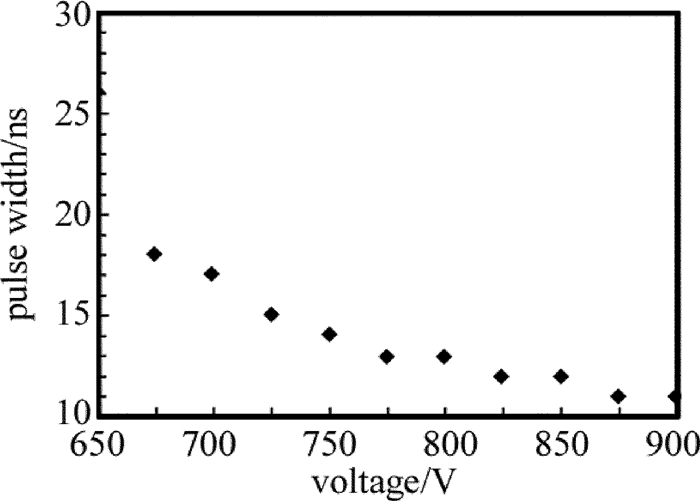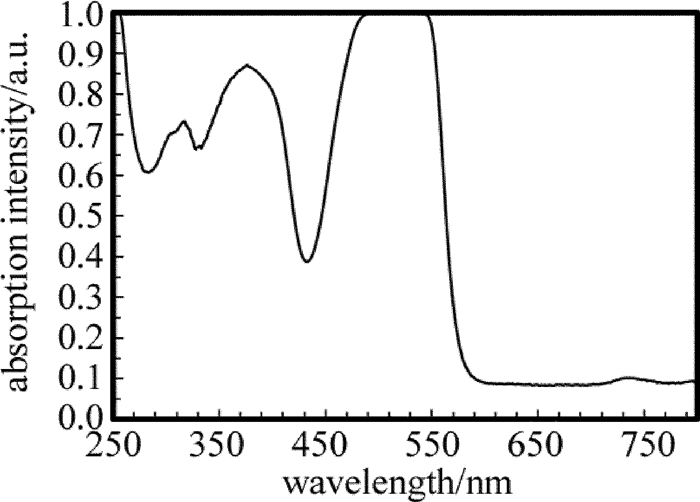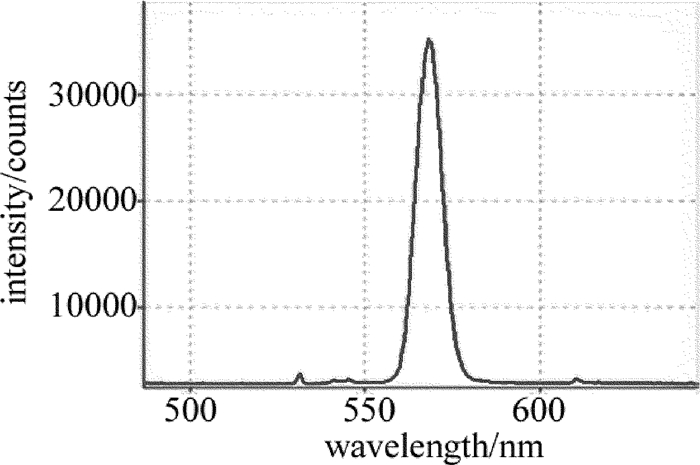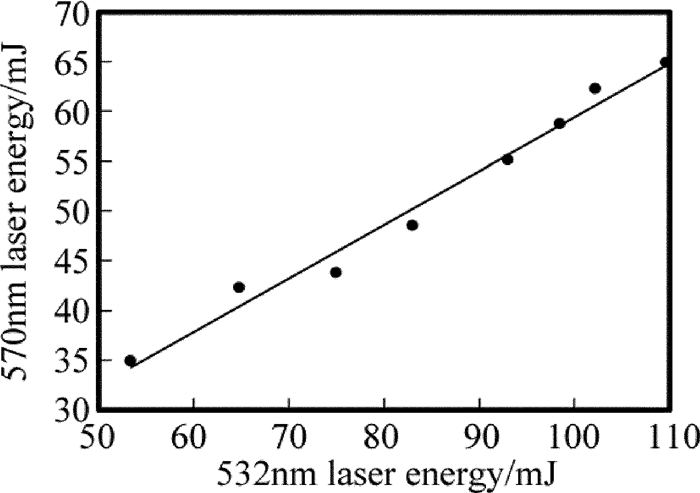HTML
-
目前,皮肤激光治疗仪已广泛地应用于各皮肤科、医疗美容医院。激光调Q是将储存在高能级的激活粒子在很短的时间内释放,从而获得高能量的激光输出。调Q激光瞬间释放激光能量时的光脉冲峰值功率很高,光脉冲靶组织作用时间短、热效应小,在治疗皮肤疾病过程中能够减小对正常皮肤的伤害。波长为1064nm和532nm调Q Nd:YAG激光治疗仪对治疗治疗咖啡斑、皮肤血管瘤、寻常疣等疾病有很好的临床效果[1-3],但这两种波段激光对于祛除彩色纹身临床效果不理想。人体氧基血红蛋白的特定荧光物质在560nm~590nm的黄-橙光波段吸收程度高,570nm波段处于氧基血红蛋白吸收峰附近,在血细胞计数、激光眼科、皮肤科治疗、生物医学检测等领域有广泛的应用前景[4-5]。在皮肤疾病治疗领域,脉冲染料激光对治疗寻常疣、葡萄酒样痣、蜘蛛痣、血管瘤、甲银屑病、黄褐斑、瘢痕取得良好效果, 同时对祛除蓝绿色纹身效果明显[6]。
磷酸氧钛钾(potassium titanyl phosphate, KTP)晶体是一种优良的非线性晶体,具有较高的非线性系数、透光范围大、走离小、价格低廉。532nm激光可由1064nm激光倍频输出[7-9]。染料是一种碳氢化合物,分子中共轭双键的电子参与光的吸收和激光辐射,脉冲染料激光以有机染料为工作物质,脉冲的方式释放激光能量。1966年,研究人员首次发现用闪光灯激励含有酞菁染料的溶液能够实现激光振荡。1967年,研究人员把激光染料掺杂到凝胶中得到固态有机染料,使之受激发射荧光[10]。固体染料激光器保留了液体染料激光器的抽运方式多样性、调谐范围宽同时,具有全固化、小型化、重量轻、使用保存方便及成本低等优点,被广泛地用作相干光源光谱、非线性光学、医学、激光雷达技术[11-16]。橙黄色的激光缺少相应的基频光输出,目前通过倍频的方式获得较困难。2010年, 长春理工大学JIANG等人通过复合内腔和频方式设计了一种全固态570nm连续波黄光激光器[17]。利用受激喇曼效应也可获得黄光脉冲输出[18],但这两种方法的光光转换效率低,固体染料激光器能够获得窄带激光输出的同时,光光转换效率非常高[19]。
为结合调Q Nd:YAG激光器和染料激光器的优良特性,本文中结合电光调Q Nd:YAG激光器、非线性倍频晶体、固体染料发光设计一款三波长激光器,可实现3种波长同时输出,在皮肤激光治疗应用中可实现选择性治疗,有利于推进皮肤激光治疗效果提高,资源合理利用,节省研发成本。
-
首先要实现调Q窄脉宽1064nm激光输出,用KTP非线性倍频晶体对1064nm基频光倍频获得532nm激光输出,倍频光可作为固体染料激光的抽运光抽运固体染料增益介质[20],辐射出光束经谐振腔振荡放大输出570nm激光光束; 实验中获得最高1064nm激光能量输出为310.5mJ,当注入倍频晶体的1064nm激光能量为300.2mJ,532nm输出能量为111.3mJ,染料激光输出光光转换效率高达61.3%;增加氙灯电压,3种波长的输出能量均增加,1064nm脉冲宽度压缩,最窄脉宽为11ns; 改变染料激光平-平腔长度,可以调节染料激光光谱特性。
实验装置如图 1所示。Nd:YAG晶体为增益介质,氙灯能够在短时间内产生高强度光照射Nd:YAG晶体棒,晶体受激辐射发光,反射镜M1对1064nm光全反,输出镜M2对1064nm光透过率为90%,采用平-平腔结构,形成自由振荡谐振腔。经电光调Q晶体和起偏器P作用后输出巨脉冲光束,出射1064nm光束通过分光棱镜后,一部分光直接输出,一部分光进入KTP非线性倍频晶体,出射532nm倍频光和部分没有进行非线性转化的1064nm光,经532nm滤波片后输出纯532nm光束。532nm光束经分光棱镜M5,一部分光直接出射,另一部分光由M6进入抽运染料增益介质,M6对532nm光透过率为95%,输出镜M7对532nm光全反,对570nm光透过率为80%。采用平-平腔结构,染料增益介质由532nm激光端面抽运后发出光束经谐振腔振荡放大输出570nm激光光束。
-
采用激光脉冲波形探测器接收调Q输出的散射光,连接到示波器显示波形,测出1064nm基频光脉冲波形半峰全宽随注入电压变化情况如图 2所示。
激光输出脉冲宽度随抽运电压的增加而逐渐变窄,这是由于当外界激发作用增强时,腔内增益系数越大,工作物质的上能级反转粒子数的累积时间和衰减时间越短,脉冲建立及熄灭过程越短,导致脉宽向变窄趋势变化。随着外界激发作用不断加强,由于饱和效应,增益和损耗达趋于平衡,脉宽变窄趋势趋于平缓。
-
调Q状态下1064nm激光输出能量随抽运电压的变化情况如图 3所示。输出能量随注入电压增加而增大,当重复频率为10Hz,注入抽运电压为900V时,输出1064nm激光能量为310.5mJ。
基频光经过倍频晶体倍频和滤波片后,输出中心波长为532nm的绿光激光,532nm倍频光输出能量随基频光能量变化如图 4所示。倍频光能量随基频光能量增大呈线性关系增大,当基频光能量为300.2mJ时,倍频光能量为111.3mJ。
-
抽运光注入电压为900V时,使用Oceanoptics公司的MAYA2000PRO光纤光谱仪测得基频光和倍频光的光谱半峰全宽(full width at half maximum, FWHM)分别为2.1nm和1.26nm,倍频光光谱变窄。利用2阶非线性介质进行频率转换输出的倍频脉冲光强I′与基频脉冲光强I的平方成正比,Imax为基频光光谱峰值光强,Imax′为倍频光光谱峰值光强。基频光光谱FWHM为:
基频光波长为λ1和λ2, 经倍频转换后, 分别为λ1/2和λ2/2。
当基频光光强为Iλ1或Iλ2时,倍频光光强为:
式中,$I^{\prime}<\frac{I_{\max }^{\prime}}{2}$,此时倍频光光谱半峰全宽为:
倍频光脉冲光谱λ1/2和λ2/2位置对应光强低于光谱半峰全宽光强位置,所以倍频光脉冲光谱半峰全宽相比基频光变窄。
2.1. 基频光脉宽和抽运光电压关系
2.2. 输出脉冲能量分析
2.3. 基频光和倍频光脉冲光谱半峰全宽关系
-
固体染料增益介质由PM597染料分子掺杂至聚甲基丙烯酸甲酯(polymethyl methacrylate, PMMA)基质制成,端面直径为25mm,侧面长度为25mm,用Lambda950紫外光分光光度计测出固体染料增益介质吸收光谱如图 5所示。染料增益介质在490nm~550nm范围内有较强吸收特性,532nm脉冲光可作为该染料激光器的抽运光。
-
用532nm脉冲激光抽运固体染料增益介质如图 6a所示,经谐振腔振荡输出中心波长为570nm黄光激光装置如图 6b所示。光谱图如图 7所示,染料激光输出波长向长波长方向移动。
被532nm脉冲光激发后染料分子的电子从激发态回到基态发光之前,会与周围的原子发生作用使其激发能的一部分以热等其它形式发生,非辐射的能量移动引起失活,因此辐射出的光子能量小于吸收的光子能量,导致输出波长红移。
抽运电压为800V时,改变固体染料激光腔M6与M7之间的距离,测得染料激光光谱半峰全宽变化情况如图 8所示。染料激光谱线半峰全宽相比532nm抽运光展宽,激光染料是含有芳香环或者芳香杂环以及共轭键体系的高分子有机化合物,存在大量的振动能级和转动能级结构,这些结构决定染料分子荧光光谱分布。染料分子掺杂到聚合物基质中,由于纳米孔的限制,使转动弛豫产生的非辐射复合减少,染料分子从激发态的不同振转能级跃迁至基态的不同振转能级上,导致光谱展宽。
增加M6与M7之间距离,染料激光谱线半峰全宽呈现变窄的趋势。在有源腔模式下, 线宽极限为:
有源腔光子寿命为:
式中, L为谐振腔光学长度,δs为单程净损耗,τr为腔内光子寿命。根据(6)式、(7)式可以推导出有源谐振腔的线宽极限与谐振腔光学长度成反比,所以增加染料激光谐振腔长度,腔内光子寿命增加,导致光谱宽度变窄。
-
用532nm激光抽运固体染料,染料激光谐振腔的输出能量随532nm激光能量变化情况如图 9所示。532nm抽运光能量为102.2mJ,输出染料激光能量为62.2mJ,光光转换效率为61.3%。
在操作过程中,染料激光的抽运光强度不可以无限提高,当激发光超过一定限度时,增益介质光吸收趋于饱和,且不可逆转地破坏激发态分子,出现光漂白现象。
3.1. 固体染料介质吸收光谱特性
3.2. 染料激光输出光谱特性
3.3. 染料激光输出能量特性
-
本文中结合电光调Q Nd:YAG激光器、非线性晶体倍频技术、固体染料发光机制,实现了1064nm,532nm,570nm三波长窄脉宽激光同时输出的激光器的研发。实验测量了3种波长脉冲能量情况,能量增长情况都基本呈线性关系,染料脉冲转换率高达61.3%;增加氙灯注入电压,基频光的脉宽向变窄方向变化;通过倍频转换,脉冲光的光谱被压缩;通过增加染料激光腔长、光谱半峰全宽,可以压缩染料脉冲光谱。该激光器其结构简单、使用方便,可以通过更换不同固体染料增益介质获得更多波长激光,在推进色素性皮肤疾病选择性治疗技术和激光器灵活应用具有重要意义。

 Map
Map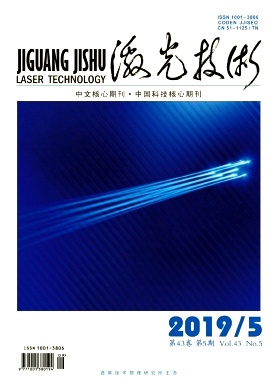


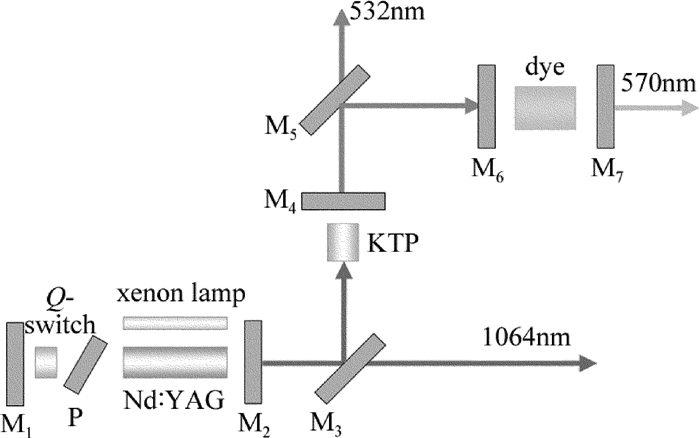


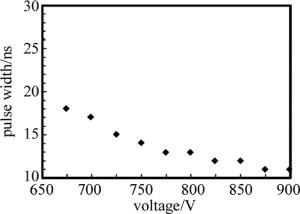
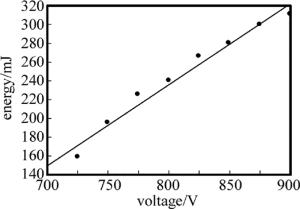
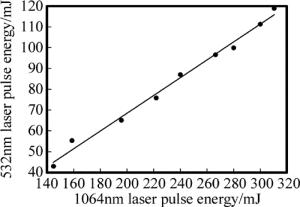


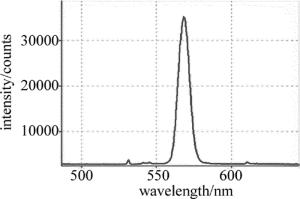
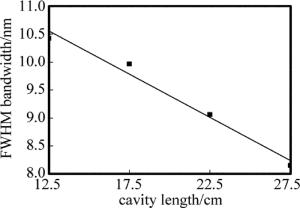

 DownLoad:
DownLoad:
